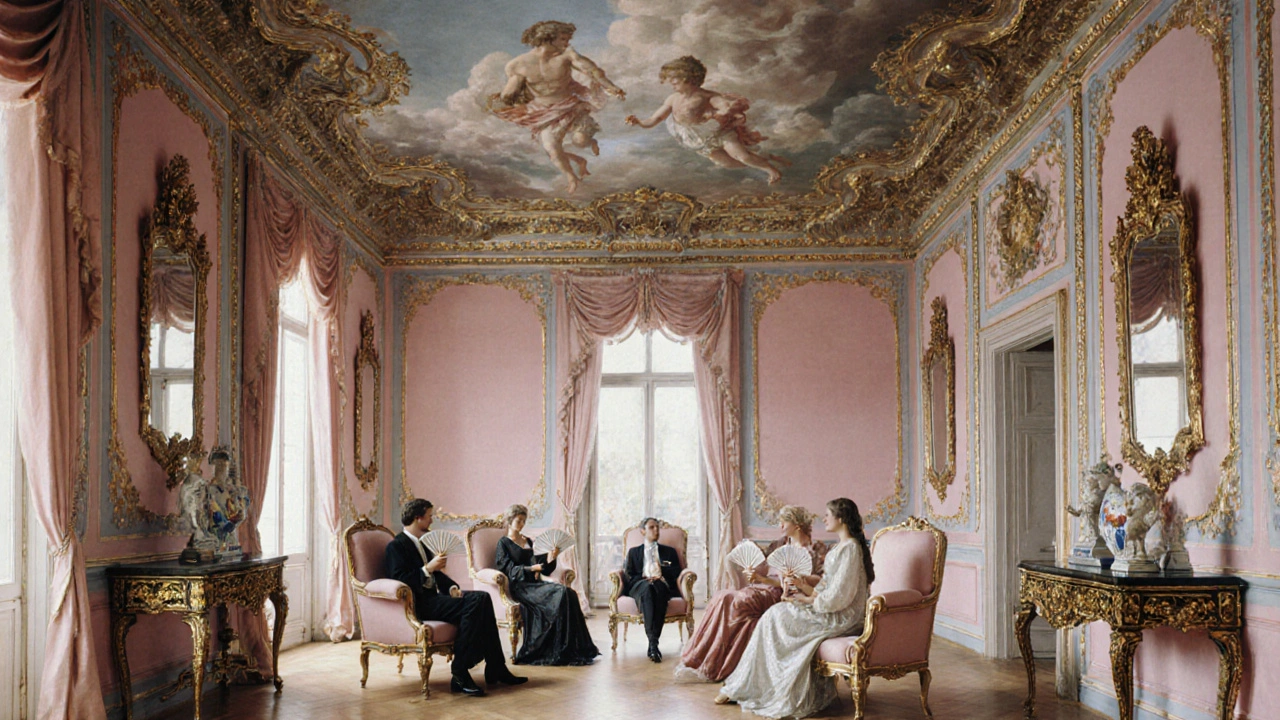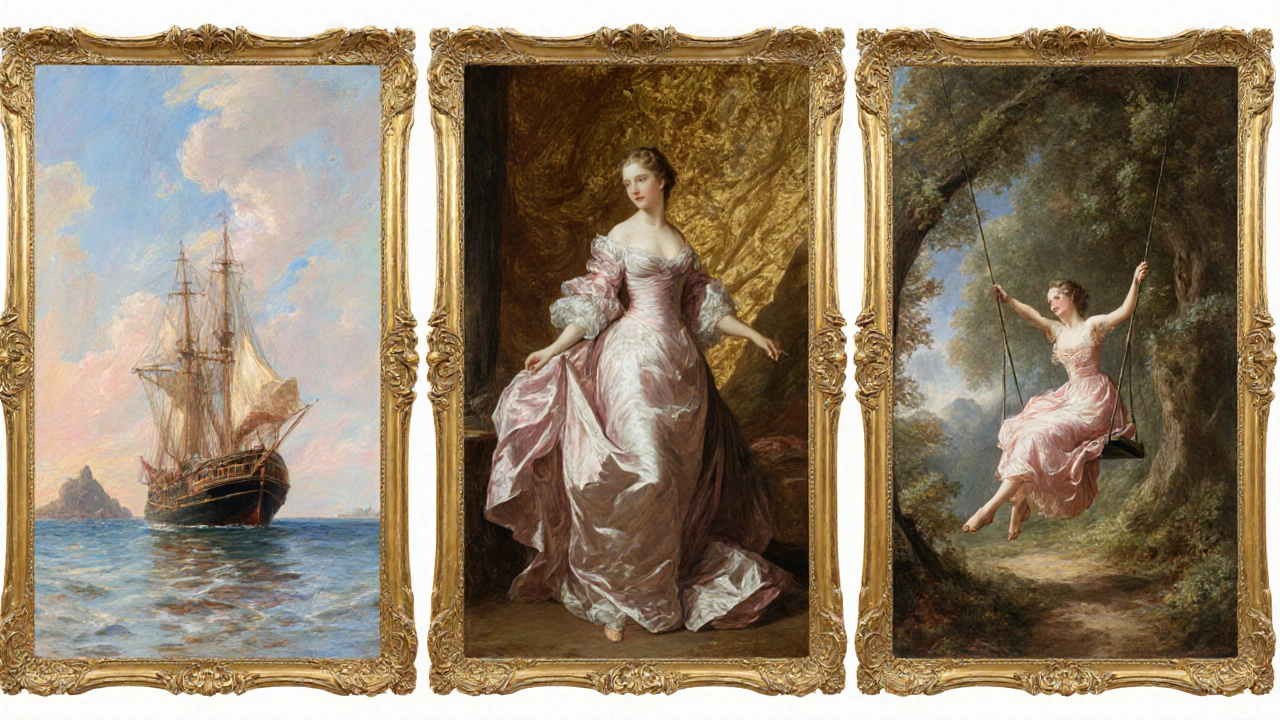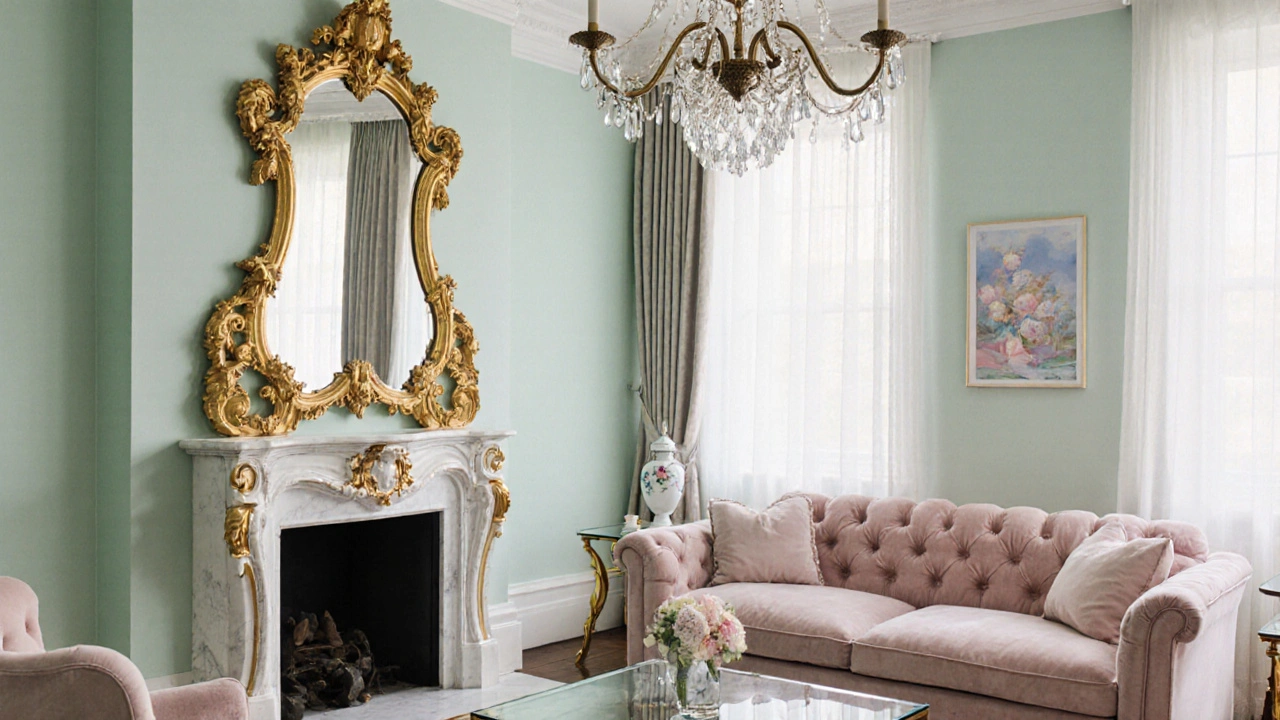Rococo: The Revolutionary Art Movement That Broke the Mold
 Oct, 11 2025
Oct, 11 2025
Rococo Art Style Explorer
Key Features
- Pastel color palette
- Asymmetrical compositions
- Playful mythological themes
- Ornate decorative elements
- Light, elegant brushwork
Notable Artists
- Antoine Watteau
- François Boucher
- Jean-Honoré Fragonard
- Jean-Baptiste-Siméon Chardin
Color Palette Explorer
Rococo art is known for its soft, pastel color palette. These colors reflect the movement's light-hearted and elegant nature.
Stylistic Comparison Table
| Aspect | Baroque | Rococo | Neoclassicism |
|---|---|---|---|
| Period | 1600–1750 | 1720–1780 | 1750–1820 |
| Core Mood | Drama, power, awe | Playfulness, intimacy | Order, rationality |
| Color Palette | Deep reds, golds, stark contrast | Pastels, light tones | Muted earth tones, restrained hues |
| Typical Themes | Religious epics, royal triumphs | Mythological love, garden fêtes | Classical history, civic virtue |
| Patronage | Church & monarchs | French aristocracy | Revolutionary governments, educated bourgeoisie |
Famous Rococo Works
Embarkation for Cythera
Antoine Watteau (1717)
A dreamy depiction of lovers departing for the island of love.
Madame de Pompadour
François Boucher (1756)
A sensual portrait showcasing Rococo's indulgent elegance.
The Swing
Jean-Honoré Fragonard (1767)
A classic example of Rococo's playful and erotic themes.
When you picture 18th‑century art, you might imagine stiff portraits or solemn religious scenes. Rococo is a light‑hearted, decorative art movement that burst onto the French scene in the early 1700s, turning the rigid seriousness of the Baroque upside down. It swapped marble gravitas for pastel frivolity, and its influence stretched from canvases to palace salons. This guide shows you why Rococo mattered, how it differed from its predecessors, and which masterpieces still make us smile today.
Quick Takeaways
- Rococo emerged in early 18th‑century France as a reaction against Baroque grandeur.
- Key traits: pastel palettes, asymmetrical designs, playful mythological scenes, and ornate interiors.
- Major artists include Antoine Watteau, François Boucher, and Jean‑Honoré Fragonard.
- Rococo influenced architecture, interior design, and even fashion before fading after the French Revolution.
- Its legacy lives on in modern decorative arts and the “feel‑good” aesthetic of contemporary design.
What Is Rococo?
Rococo, sometimes called “Late Baroque,” is a art movement characterized by lightness, elegance, and exuberant decoration. It first sprouted in Parisian salons around 1720, fueled by the aristocracy’s desire for intimate, whimsical spaces. Unlike the dramatic chiaroscuro of the previous era, Rococo works favor soft lighting, fluid brushstrokes, and a sense of movement that feels almost cinematic.
Historical Context: From Baroque to Enlightenment
To understand why Rococo broke the mold, you need to see what came before it. The Baroque style that dominated the 17th century featured bold contrasts, grandiose scale, and religious intensity. By the early 1700s, the French court, especially under Louis XV, grew weary of such weight. The growing Enlightenment intellectual movement championing reason, pleasure, and individual sentiment encouraged a more personal, pleasure‑seeking aesthetic. Rococo answered that call by turning art into a celebration of leisure, love, and nature.

Key Characteristics of Rococo Art
- Pastel Color Palette: Soft pinks, powder blues, and creamy yellows dominate.
- Asymmetrical compositions that swirl like vines, creating a sense of movement.
- Playful subject matter-mythological lovers, garden fêtes, and everyday aristocratic life.
- Delicate brushwork that captures the texture of silk, porcelain, and foliage.
- Ornamental motifs such as shells (rocaille), scrolls, and arabesques that spill over frames and walls.
Major Artists and Iconic Works
The personality of Rococo shines through its painters. Antoine Watteau is credited with inventing the fête galante genre, depicting aristocrats in dreamy garden settings. His masterpiece “Embarkation for Cythera” (1717) captures the fleeting moment of lovers departing for the goddess of love’s island.
François Boucher specialized in voluptuous mythological scenes and delicate portraits. Works like “Madame de Pompadour” (1756) blend sensuality with meticulous detail, embodying the court’s taste for indulgence.
Jean‑Honoré Fragonard pushed Rococo’s flirtatious edge to ecstatic extremes. His “The Swing” (1767) remains a textbook example of light, airy composition and playful eroticism.
Other notable figures include Jean-Baptiste-Siméon Chardin who applied Rococo’s softness to humble still‑lives, showing the movement’s versatility. Together, these artists turned painting into a visual party.
Rococo vs. Baroque vs. Neoclassicism
| Aspect | Baroque | Rococo | Neoclassicism |
|---|---|---|---|
| Period | 1600-1750 | 1720-1780 | 1750-1820 |
| Core Mood | Drama, power, awe | Playfulness, intimacy | Order, rationality |
| Color Palette | Deep reds, golds, stark contrast | Pastels, light tones | Muted earth tones, restrained hues |
| Typical Themes | Religious epics, royal triumphs | Mythological love, garden fêtes | Classical history, civic virtue |
| Patronage | Church & monarchs | French aristocracy | Revolutionary governments, educated bourgeoisie |

Impact on Architecture and Interior Design
Rococo didn’t stay on canvas; it poured into walls, ceilings, and furniture. The Amalienburg palace pavilion near Munich, built in 1765, showcases quintessential Rococo interiors with mirrored walls, gilded stucco, and elaborate frescoes. French salons filled with sinuous mirrors, pastel upholstery, and intricate carving created spaces where conversation felt like a performance.
Even everyday objects-porcelain, silverware, and textiles-adopted the same airy motifs. The craze for “cabbage‑leaf” chairs and asymmetrical mantelpieces spread across Europe, blurring the line between fine art and functional design.
Decline and Lasting Legacy
The French Revolution (1789) marked the end of Rococo’s aristocratic patronage. The new Republic favored the moral seriousness of Neoclassicism, branding Rococo as “decadent.” Yet the movement’s playful spirit survived. 19th‑century artists like Édouard Manet revived its color sensibility, and the 20th‑century Art Nouveau borrowed its flowing lines.
Today, interior designers reference Rococo’s pastel palette and curvilinear forms to create “soft‑luxury” spaces. Even pop culture-think of the whimsical set designs in films like “Marie Antoinette” (2006)-draws heavily from Rococo’s visual language.
Frequently Asked Questions
What differentiates Rococo from Baroque?
Baroque emphasizes drama, strong contrast, and religious or royal grandeur, while Rococo favors light pastel colors, playful subjects, and intimate, decorative compositions.
Who are the most famous Rococo painters?
Key figures include Antoine Watteau, François Boucher, Jean‑Honoré Fragonard, and Jean‑Baptiste-Siméon Chardin.
Did Rococo influence architecture outside France?
Absolutely. German, Austrian, and Italian palaces adopted Rococo interiors-examples include the Amalienburg in Bavaria and the Würzburg Residence in Germany.
Why did Rococo fall out of favor?
The political upheavals of the French Revolution rejected aristocratic excess, turning to the moral clarity of Neoclassicism, which made Rococo seem frivolous.
How can I incorporate Rococo elements into modern décor?
Start with pastel walls, gilded picture frames, and asymmetrical mirror panels. Adding delicate sculptural details-like shell motifs on furniture-evokes the Rococo vibe without overwhelming a contemporary space.
Next Steps for Curious Readers
- Visit a local museum with a Rococo collection-many European museums offer virtual tours if travel isn’t feasible. \n
- Read a focused monograph, such as "Rococo: Art and Design in an Age of Excess" to deepen historical context.
- Try a DIY interior project: repaint a small room in pastel hues and add a few ornamental mirrors.
- Explore related movements-compare Rococo’s lightness with the later Neoclassical emphasis on order.